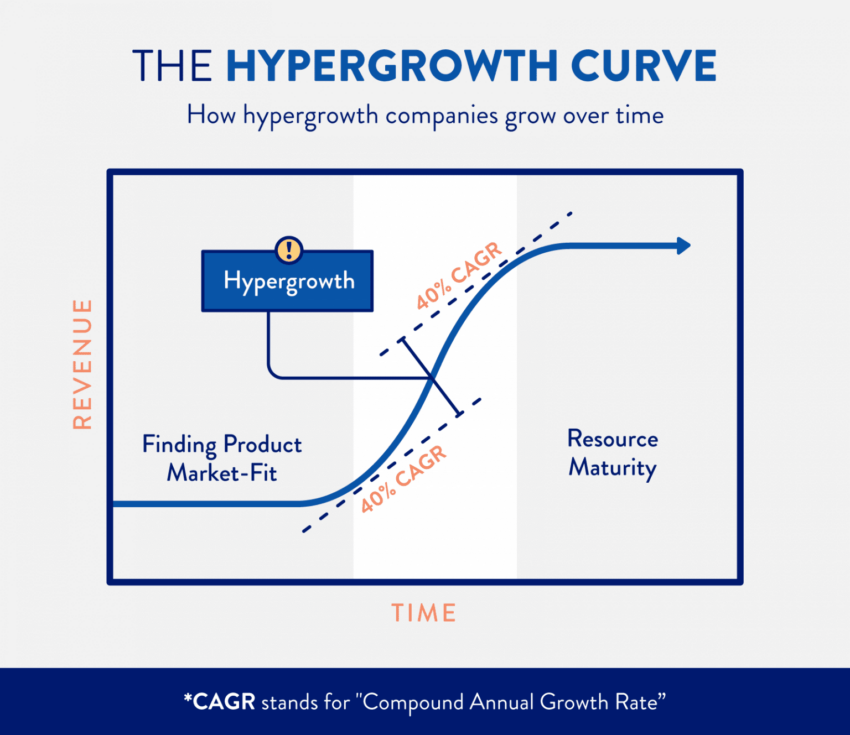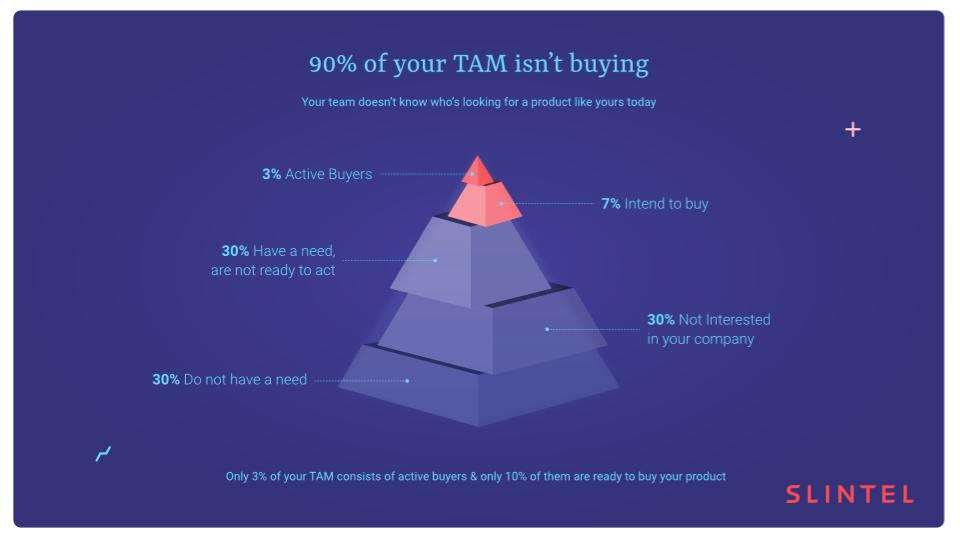Effects of Growing Fast in SaaS (And How to Fix Them)
All my life, I’ve worked at SaaS organizations that have gone warp speed into the fabled hypergrowth stage. If you’ve never heard the term before, the hypergrowth stage is the period in which a company experiences a compound annual growth rate (CAGR) of greater than 40%, after finding product-market fit. It’s an exciting phase that lasts for just a few years until that CAGR curve tapers off into a more gentle, steady, not-so-vertical line.

In this phase, I’ve come to realize that the marketing/sales teams of every organization experience similar problems and have the same pain points. Often found in the form of:
- Bad practices/missed opportunities when it comes to capturing valuable lead insights that can help improve sales and revenue
- Taxing, manual marketing and sales processes that require a ton of manpower
- A “spray and pray” attitude in outbound by spending (read: wasting) time chasing prospects that were never going to make a purchase in the first place. Because hey, leave no stone unturned, amirite?
If you’ve worked at a growing SaaS company, then you’ve either experienced this too, or come up with an intelligent solution to fix this before it could happen. If you did the latter, I tip my hat to you. However, if you didn’t, I’d like to introduce you to two golden phrases and a bunch of action items that might just change your life.
Let’s start with the golden phrases; “sales intelligence” and “buying intent.” Funny enough, knowledge and implementation of these two things can fix all of the three problems listed above. I’m going to break all of them down into actionable steps that you can use to make your workflows more efficient, intelligent, and organized.
1. Fixing bad practices and capturing lead insights more efficiently
Going to LinkedIn for insights every single time a lead comes into the system, or waiting until you talk to the prospect on a discovery call is not the most efficient way to capture lead insights. The former is time consuming, and the latter might not be the best place to get these insights.
What you need to do is allow the machines to fetch you this information and bring it right to your system. This way, you can head into your discovery call with a ton of insights, and spend the discovery call asking other relevant questions. So, how can you make this happen?
Step 1: Set up efficient tracking across your website
While there are several marketing automation tools that will do this for you, an easy example would be HubSpot. HubSpot tracks your prospect’s website behavior and gives you insights on the pages they visited, their location, and other relevant web analytics information that can help you understand what they need.
Which blog post did they read? What did they download from your website? Did they land on your website from a paid ad that was pitching you as an alternative to a particular competitor? Which country are they from? HubSpot can give you answers to all these questions. You shouldn’t have to ask your prospects these questions, and can instead be in a position to help them from the get-go in your discovery call.
Step 2: Integrate your CRM with a sales intelligence platform
Sales intelligence software like Slintel can integrate with your CRM to give you contextual insights on every lead in your system. Company size, tech stacks, contact information–you name it, you have it. Instead of making your SDRs manually collect all this information, you can have your sales intelligence tool or data partner enrich this information in your CRM directly, saving your team a ton of time and effort.
Step 3: Train your SDRs to look at the intel first
Ask your SDRs to look at all the automated information that was gathered in the CRM first before even making their next move. Set up lead qualification criteria, and train your SDRs to get excited about seeing a valid lead come into the system, instead of getting hyped just when a lead gets assigned to them. If they look at a lead and realize that it’s a bad-fit prospect that’s come into the system, then they can forget about pursuing the lead right there, saving them valuable time that they could spend elsewhere.
Now that that’s outta the way, let’s go to the next one.
2. Managing overly-manual, resource-heavy marketing/sales processes
Well, the short answer is: “automate things as much as you can.”
But there’s more to it than just that. Here’s the long version of the answer.
Typically, marketing and sales teams have manual processes around two major things:
a. Marking the lead/opportunity stage accurately and maintaining an organized database in their CRM with insightful comments about each prospect
What you need to understand here is that salespeople will always have the thirst to get more revenue, but never have the time to mark leads accurately for what they are.
So the way to make this happen is by gating things from moving forward (this might sound counterproductive to the actual fix, but give me a second to explain). Set up your system in such a way that if certain action items are not attended to, they can’t push the prospect to the next stage, but at the same time, make it easier for your team to add relevant information to the CRM.
If you’re at a hypergrowth company, then you’ve most likely set up the first part of this process already. For example, when your SDR realizes that a lead is qualified, then they know it’s time to convert the lead into an opportunity, but you already have some mandatory fields they need to fill before moving the prospect forward to the next step.
However, if you ask them to enter a ton of text information at this step, then they’re either going to be overburdened with manual work right away, or will choose to ignore protocol and convert the lead anyways. This is where good processes will help.
Here’s how you can fix this.
Step 1: (If you haven’t already) Create Dependencies
Set up your system in such a way that it doesn’t allow leads to pass through if certain criteria aren’t met. Make it mandatory for your SDRs/AEs to fill up certain fields before pushing the prospect to the next phase. These can be things like “Solution Prospect Is Looking For,” “Major Pain Points,” or “Currently Customer Of” for instance.
Step 2: Templates and Drop-Downs
This is the real fix. While it’s important to ask your sales team to fill up these pieces of information, it’s your job to put all the relevant information under drop-downs so it only takes a few seconds for your team members to do it. For fields that require longer answers, like choosing “What Would Help Reverse Their Decision” before moving them to Closed Lost, you can create templates around the most common reasons you lose deals and ask your AEs to pick one from that list.
Step 3: Sales intelligence again!
If you have certain fields that can be automatically filled in using a sales intelligence software, then go ahead and do it! A company’s technology stack, revenue, recent purchases or employee strength might be mandatory fields you want to capture before moving them to the next phase of their customer journey. Wherever you can do it, make sure you automate it.
b. Sending emails, follow-ups, and other communications to prospects in the pipe
This should never, ever, be a manual process for your sales team. While it might be difficult to standardize this for prospects that are deep in the funnel, you need to make sure that you make this as simple as you can for your SDRs and AEs.
If your company is in the hypergrowth phase, then you most likely have this set up already, but the question is, how effectively has your email sequencing been set up? Several companies have multiple outreach templates and sequences set up, but email sequencing software can be put it to much better use.
For example, when a deal is getting pushed from Negotiation to Agreement Shared, do you have an automated email set up that sends your prospect an email or a relevant resource over? Take a deeper look at your system and see what are all the different things that can be automated. Then, automate them.
3. Stop pursuing low-intent leads
We’ve all seen this happen in companies that want to grow aggressively. They hire 20 new SDRs, 10 new AEs, and get them to ring up every company on the planet to see if they’re interested.
Unfortunately, this kind of selling doesn’t work scalably. Why? Because not everyone in your addressable market is buying, so you’re just wasting your time!
Only 3% of your TAM is actively looking for a product like yours today. There’s another 7% that has a requirement for a product like yours, but isn’t actively searching.
The other 90% simply isn’t buying, and will say “NO” when you pitch them.

So, what do you do? Well, you determine the buying intent of your prospect before reaching out to them, of course.
Step 1: Determine buying intent
I’m not gonna demystify buying intent here, there’s a link below for that.
What you need to know is that there are different ways to capture buying intent; a well known one being search based intent where a tool can point out to you companies and individuals who show specific search behaviour and are prime candidates to make a purchase. But searches happen almost at the end stage of a B2B buyer journey. There are other methods of capturing intent like studying purchase patterns, contract renewal dates or key hires. These methods indicate B2B buyer intent at a much earlier stage of the buyer journey.
Get software that can integrate with your current stack and find out who’s on the lookout for a product/service like yours today and who isn’t. It should work for leads that are already in your system, the ones coming into your system and the ones that you proactively should reach out to.
Instead of focusing on breadth, focus on depth, and how you can run account-based campaigns and use personalized outreach messages to improve your conversion rate.
Step 2: Set up lead scoring
Lead scoring is an entire subject by itself, but to efficiently understand the likelihood of your prospect purchasing your offering, you need to understand how much they are engaging with you, how well your software solves their problem, and assign each lead/prospect a score based on that.
You can learn more about buying intent and lead scoring here.
Grow even faster!
Once you fix all these things, I can assure you that your SaaS company will grow faster than it did earlier, and help you bring in more revenue. None of these things are actually difficult to implement, but I will tell you this—they take some trial and error before you concoct the perfect setup. All the best, and if you liked this post, please share it with your team or on social media using one of the buttons below.
